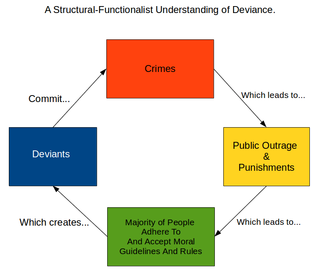Negligence is a failure to exercise appropriate and/or ethical ruled care expected to be exercised amongst specified circumstances. The area of tort law known as negligence involves harm caused by failing to act as a form of carelessness possibly with extenuating circumstances. The core concept of negligence is that people should exercise reasonable care in their actions, by taking account of the potential harm that they might foreseeably cause to other people or property.
This article addresses torts in United States law. As such, it covers primarily common law. Moreover, it provides general rules, as individual states all have separate civil codes. There are three general categories of torts: intentional torts, negligence, and strict liability torts.

Forensic psychiatry is a subspeciality of psychiatry and is related to criminology. It encompasses the interface between law and psychiatry. According to the American Academy of Psychiatry and the Law, it is defined as "a subspecialty of psychiatry in which scientific and clinical expertise is applied in legal contexts involving civil, criminal, correctional, regulatory, or legislative matters, and in specialized clinical consultations in areas such as risk assessment or employment." A forensic psychiatrist provides services – such as determination of competency to stand trial – to a court of law to facilitate the adjudicative process and provide treatment, such as medications and psychotherapy, to criminals.
A duty to warn is a concept that arises in the law of torts in a number of circumstances, indicating that a party will be held liable for injuries caused to another, where the party had the opportunity to warn the other of a hazard and failed to do so.
Negligence in employment encompasses several causes of action in tort law that arise where an employer is held liable for the tortious acts of an employee because that employer was negligent in providing the employee with the ability to engage in a particular act. Four basic causes of action may arise from such a scenario: negligent hiring, negligent retention, negligent supervision and negligent training. While negligence in employment may overlap with negligent entrustment and vicarious liability, the concepts are distinct grounds of liability. The doctrine that an employer is liable for torts committed by employees within the scope of their employment is called respondeat superior.
In tort law, the standard of care is the only degree of prudence and caution required of an individual who is under a duty of care.

Bolam v Friern Hospital Management Committee [1957] 1 WLR 582 is an English tort law case that lays down the typical rule for assessing the appropriate standard of reasonable care in negligence cases involving skilled professionals such as doctors. This rule is known as the Bolam test, and states that if a doctor reaches the standard of a responsible body of medical opinion, they are not negligent. Bolam was rejected in the 2015 Supreme Court decision of Montgomery v Lanarkshire Health Board in matters of informed consent.
Tarasoff v. Regents of the University of California, 17 Cal. 3d 425, 551 P.2d 334, 131 Cal. Rptr. 14, was a case in which the Supreme Court of California held that mental health professionals have a duty to protect individuals who are being threatened with bodily harm by a patient. The original 1974 decision mandated warning the threatened individual, but a 1976 rehearing of the case by the California Supreme Court called for a "duty to protect" the intended victim. The professional may discharge the duty in several ways, including notifying police, warning the intended victim, and/or taking other reasonable steps to protect the threatened individual.

Emergency psychiatry is the clinical application of psychiatry in emergency settings. Conditions requiring psychiatric interventions may include attempted suicide, substance abuse, depression, psychosis, violence or other rapid changes in behavior. Psychiatric emergency services are rendered by professionals in the fields of medicine, nursing, psychology and social work. The demand for emergency psychiatric services has rapidly increased throughout the world since the 1960s, especially in urban areas. Care for patients in situations involving emergency psychiatry is complex.
Causation is the "causal relationship between the defendant's conduct and end result". In other words, causation provides a means of connecting conduct with a resulting effect, typically an injury. In criminal law, it is defined as the actus reus from which the specific injury or other effect arose and is combined with mens rea to comprise the elements of guilt. Causation only applies where a result has been achieved and therefore is immaterial with regard to inchoate offenses.
Involuntary treatment refers to medical treatment undertaken without the consent of the person being treated. Involuntary treatment is permitted by law in some countries when overseen by the judiciary through court orders; other countries defer directly to the medical opinions of doctors.
In law, an omission is a failure to act, which generally attracts different legal consequences from positive conduct. In the criminal law, an omission will constitute an actus reus and give rise to liability only when the law imposes a duty to act and the defendant is in breach of that duty. In tort law, similarly, liability will be imposed for an omission only exceptionally, when it can be established that the defendant was under a duty to act or duty of care.
In English tort law, an individual may owe a duty of care to another, in order to ensure that they do not suffer any unreasonable harm or loss. If such a duty is found to be breached, a legal liability will be imposed upon the tortfeasor to compensate the victim for any losses they incur. The idea of individuals owing strangers a duty of care – where beforehand such duties were only found from contractual arrangements – developed at common law, throughout the 20th century. The doctrine was significantly developed in the case of Donoghue v Stevenson, where a woman succeeded in establishing a manufacturer of ginger beer owed her a duty of care, where it had been negligently produced. Following this, the duty concept has expanded into a coherent judicial test, which must be satisfied in order to claim in negligence.
In medical law and medical ethics, the duty to protect is the responsibility of a mental health professional to protect patients and others from foreseeable harm. If a client makes statements that suggest suicidal or homicidal ideation, the clinician has the responsibility to take steps to warn potential victims, and if necessary, initiate involuntary commitment. The majority of people have, at some stage, had thoughts about killing someone.
Sidaway v. Board of Governors of the Bethlem Royal Hospital [1985] AC 871 is an important House of Lords case in English tort law, specifically medical negligence, concerning the duty of a surgeon to inform a patient of the risks before undergoing an operation.

Ewing v. Goldstein15 Cal. Rptr. 3d 864 is a landmark court case that extended California mental health professional's duty to protect identifiable victims of potentially violent persons, as established by Tarasoff v. Regents of the University of California, to include acting upon communications from third parties that indicate a possible threat.
The obligatory dangerousness criterion is a principle present in the mental health law of many developed countries. It mandates evidence of dangerousness to oneself or to others before involuntary treatment for mental illness. The term "dangerousness" refers to one's ability to hurt oneself or others physically or mentally within an imminent time frame, and the harm caused must have a long-term effect on the person(s).
Molien v. Kaiser Foundation Hospitals, 27 Cal. 3d 916 (1980), was a case decided by the Supreme Court of California that first recognized that a "direct victim" of negligence can recover damages for emotional distress without an accompanying physical injury.
Political abuse of psychiatry, also commonly referred to as punitive psychiatry, is the misuse of psychiatry, including diagnosis, detention, and treatment, for the purposes of obstructing the human rights of individuals and/or groups in a society. In other words, abuse of psychiatry is the deliberate action of having citizens psychiatrically diagnosed who need neither psychiatric restraint nor psychiatric treatment. Psychiatrists have been involved in human rights abuses in states across the world when the definitions of mental disease were expanded to include political disobedience. As scholars have long argued, governmental and medical institutions code menaces to authority as mental diseases during political disturbances. Nowadays, in many countries, political prisoners are sometimes confined and abused in psychiatric hospitals.

Jane Doe No. 14 v. Internet Brands, Inc., 767 F.3d 894 (2014), is a 2014 ruling at the Ninth Circuit Court of Appeals over the legal liability of an Internet service provider for criminal offenses committed by its users. The ultimate ruling in the case has caused confusion over the amount of liability faced by service providers during such incidents.





